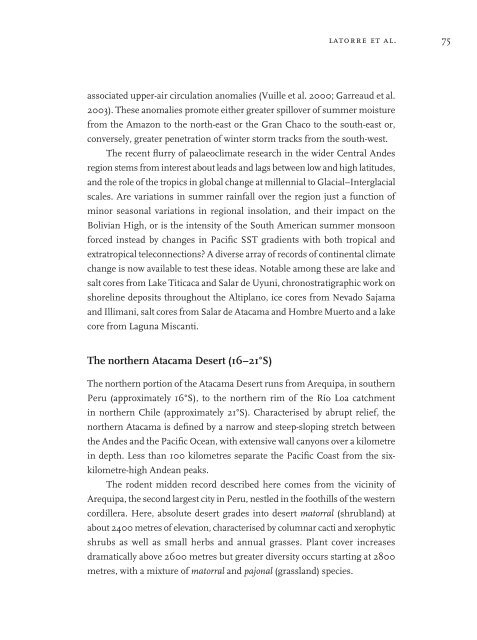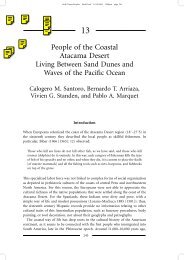Late Quaternary History of the Atacama Desert.
Late Quaternary History of the Atacama Desert.
Late Quaternary History of the Atacama Desert.
Create successful ePaper yourself
Turn your PDF publications into a flip-book with our unique Google optimized e-Paper software.
latorre et al. 75associated upper-air circulation anomalies (Vuille et al. 2000; Garreaud et al.2003). These anomalies promote ei<strong>the</strong>r greater spillover <strong>of</strong> summer moisturefrom <strong>the</strong> Amazon to <strong>the</strong> north-east or <strong>the</strong> Gran Chaco to <strong>the</strong> south-east or,conversely, greater penetration <strong>of</strong> winter storm tracks from <strong>the</strong> south-west.The recent flurry <strong>of</strong> palaeoclimate research in <strong>the</strong> wider Central Andesregion stems from interest about leads and lags between low and high latitudes,and <strong>the</strong> role <strong>of</strong> <strong>the</strong> tropics in global change at millennial to Glacial–Interglacialscales. Are variations in summer rainfall over <strong>the</strong> region just a function <strong>of</strong>minor seasonal variations in regional insolation, and <strong>the</strong>ir impact on <strong>the</strong>Bolivian High, or is <strong>the</strong> intensity <strong>of</strong> <strong>the</strong> South American summer monsoonforced instead by changes in Pacific SST gradients with both tropical andextratropical teleconnections? A diverse array <strong>of</strong> records <strong>of</strong> continental climatechange is now available to test <strong>the</strong>se ideas. Notable among <strong>the</strong>se are lake andsalt cores from Lake Titicaca and Salar de Uyuni, chronostratigraphic work onshoreline deposits throughout <strong>the</strong> Altiplano, ice cores from Nevado Sajamaand Illimani, salt cores from Salar de <strong>Atacama</strong> and Hombre Muerto and a lakecore from Laguna Miscanti.The nor<strong>the</strong>rn <strong>Atacama</strong> <strong>Desert</strong> (16–21°S)The nor<strong>the</strong>rn portion <strong>of</strong> <strong>the</strong> <strong>Atacama</strong> <strong>Desert</strong> runs from Arequipa, in sou<strong>the</strong>rnPeru (approximately 16°S), to <strong>the</strong> nor<strong>the</strong>rn rim <strong>of</strong> <strong>the</strong> Río Loa catchmentin nor<strong>the</strong>rn Chile (approximately 21°S). Characterised by abrupt relief, <strong>the</strong>nor<strong>the</strong>rn <strong>Atacama</strong> is defined by a narrow and steep-sloping stretch between<strong>the</strong> Andes and <strong>the</strong> Pacific Ocean, with extensive wall canyons over a kilometrein depth. Less than 100 kilometres separate <strong>the</strong> Pacific Coast from <strong>the</strong> sixkilometre-highAndean peaks.The rodent midden record described here comes from <strong>the</strong> vicinity <strong>of</strong>Arequipa, <strong>the</strong> second largest city in Peru, nestled in <strong>the</strong> foothills <strong>of</strong> <strong>the</strong> westerncordillera. Here, absolute desert grades into desert matorral (shrubland) atabout 2400 metres <strong>of</strong> elevation, characterised by columnar cacti and xerophyticshrubs as well as small herbs and annual grasses. Plant cover increasesdramatically above 2600 metres but greater diversity occurs starting at 2800metres, with a mixture <strong>of</strong> matorral and pajonal (grassland) species.
















